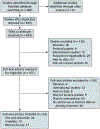Using Electronic Health Record Portals to Improve Patient Engagement: Research Priorities and Best Practices
- PMID: 32479176
- PMCID: PMC7800164
- DOI: 10.7326/M19-0876
Using Electronic Health Record Portals to Improve Patient Engagement: Research Priorities and Best Practices
Abstract
Ninety percent of health care systems now offer patient portals to access electronic health records (EHRs) in the United States, but only 15% to 30% of patients use these platforms. Using PubMed, the authors identified 53 studies published from September 2013 to June 2019 that informed best practices and priorities for future research on patient engagement with EHR data through patient portals, These studies mostly involved outpatient settings and fell into 3 major categories: interventions to increase use of patient portals, usability testing of portal interfaces, and documentation of patient and clinician barriers to portal use. Interventions that used one-on-one patient training were associated with the highest portal use. Patients with limited health or digital literacy faced challenges to portal use. Clinicians reported a lack of workflows to support patient use of portals in routine practice. These studies suggest that achieving higher rates of patient engagement through EHR portals will require paying more attention to the needs of diverse patients and systematically measuring usability as well as scope of content. Future work should incorporate implementation science approaches and directly address the key role of clinicians and staff in promoting portal use.
Conflict of interest statement
References
-
- U.S. Government Accountability Office. Health information technology: HHS should assess the effectiveness of its efforts to enhance patient access to and use of electronic health information. Washington, DC: U.S. Government Accountability Office; March 2017. Accessed at www.gao.gov/products/GAO-17-305?utm_source=blog&utm_medium=social&utm_ca... on 28 September 2019.

